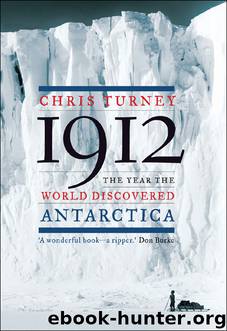1912 by Chris Turney

Author:Chris Turney [Turney, Chris]
Language: eng
Format: epub
ISBN: 9781619021372
Publisher: Counterpoint
Not six weeks after the Tokyo parade for Shirase’s men, Emperor Meiji died and the nation went into mourning. The emperor who had heralded a new start for Japan had passed away—and so, it seemed, had the nation’s interest in Antarctica. This could not have come at a worse time for Shirase. There had been talk of continuing the research in the Southern Ocean for a further two years, but the funding simply was not there: the extra year south had added a lot to an already huge bill. Though Shirase had returned home a hero he was also met with bad news. Fundraising had continued after the expedition sailed, but there remained a major shortfall: ¥53,000.
There was not enough money to pay the salaries owed, and rumours circulated that the Supporters’ Association had spent far too much on entertainment. True or not, it still meant Shirase was left to meet the commitment. Unlike Shackleton’s case, the government did not step in, and with no imperial champion Shirase was left largely on his own, financially crippled. The Kainan-maru was sold to its previous owner, Gunji, for ¥20,000 and returned to fishing. The remaining money had to be raised through a string of different ventures.
Shirase spent the next five years touring Japan, giving lectures. He sold his house in Tokyo, too—but it was not enough. During the years 1921 to 1924 Shirase returned to the Kuril Islands to put his knowledge of foxes to good use. By managing a fur farm he was able to earn some of the money owed. He returned to mainland Japan and grew his own vegetables to live off. Yet Shirase’s interest in Antarctica did not wane. In 1927 he finally met Amundsen, when the Norwegian visited the imperial family in Tokyo to show them the details of a planned flight over the North Geographic Pole.
In an attempt to gain wider recognition of the Japanese effort, Masakichi Ikeda appears to have assumed the role of the official expedition scientist. He sent a map to the Royal Geographic Society in London, incorporating the Japanese Antarctic findings with those of Amundsen. In it, Ikeda names two prominent mountains in King Edward VII Land as Mount Nobu and Mount Okuma, while the inlet at the eastern extremity of the Great Ice Barrier was declared to be Murakami Inlet, after one of the major expedition supporters—though it eventually became Okuma Bay.
The map was duly noted, filed away in the archives, and forgotten. Indeed, the society and its most senior people seem to have ignored the expedition after this. The secretary of the RGS, Scott Keltie, wrote to Lord Curzon in September 1912 and remarked, unimpressed, ‘A member of the Japan Antarctic Expedition has sent to the President a note of some of their discoveries, which do not amount to very much. I suppose I had better acknowledge it?’ Sir Clements Markham’s history of polar exploration, Lands of Silence, makes no mention of the Japanese effort and no reports on their findings were made in the society’s journal for years.
Download
This site does not store any files on its server. We only index and link to content provided by other sites. Please contact the content providers to delete copyright contents if any and email us, we'll remove relevant links or contents immediately.
| Africa | Americas |
| Arctic & Antarctica | Asia |
| Australia & Oceania | Europe |
| Middle East | Russia |
| United States | World |
| Ancient Civilizations | Military |
| Historical Study & Educational Resources |
The Boy, the Mole, the Fox and the Horse by Charlie Mackesy(2453)
Fatal Storm by Rob Mundle(1788)
Iced In by Chris Turney(1579)
Erebus by Michael Palin(1522)
Alone by Richard E. Byrd(1435)
The White Darkness by David Grann(1321)
South with the Sun by Lynne Cox(1223)
Mawson's Will by Lennard Bickel(1146)
Big Dead Place: Inside the Strange and Menacing World of Antarctica (Large Print 16pt) by Nicholas Johnson(1116)
Caroline Alexander by The Endurance: Shackleton's Legendary Antarctic Expedition(1099)
The Stowaway by Laurie Gwen Shapiro(1031)
South Pole by Elizabeth Leane(980)
A Farewell to Ice: A Report from the Arctic by Peter Wadhams(968)
In the Kingdom of Ice by Hampton Sides(964)
Ice by Unknown(964)
The Ice Master by Jennifer Niven(947)
Colony by unknow(901)
The Ice Balloon: S. A. Andree and the Heroic Age of Arctic Exploration by Wilkinson Alec(900)
Frozen in Time by John Geiger & John Geiger(891)
